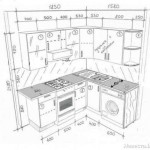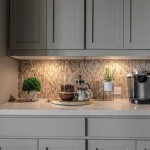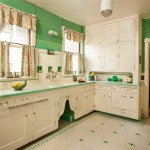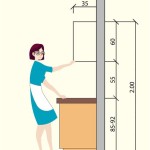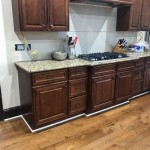Revitalizing Your Kitchen: Navigating the Options for Changing Vinyl Kitchen Cabinets
Vinyl kitchen cabinets, a popular choice for many homeowners, offer a blend of affordability and durability. However, over time, changes in style preferences, wear and tear, or simply the desire for a refreshed look can lead to the need to alter or replace these cabinets. This article explores various strategies for changing vinyl kitchen cabinets, covering factors to consider, the benefits and drawbacks of different approaches, and practical guidance to help homeowners make informed decisions.
When considering a change to vinyl kitchen cabinets, it is essential to first assess the overall condition of the cabinets themselves. Are the cabinet boxes structurally sound, or are they showing signs of water damage, warping, or significant wear? Are the hinges and drawer slides still functioning properly? The answers to these questions will largely determine whether a simple cosmetic update, a refacing project, or a complete replacement is the most appropriate course of action. Furthermore, consider the layout of the kitchen. Are you satisfied with the existing configuration, or do you envision a different arrangement that better suits your needs and lifestyle? This analysis provides a solid foundation for planning the project.
The budget available for the project will also significantly influence the choices that can be made. A limited budget might necessitate focusing on cost-effective solutions, such as painting or replacing hardware, while a larger budget could accommodate a more extensive renovation, including refacing or complete cabinet replacement. It is crucial to establish a realistic budget early in the planning process to avoid overspending and ensure that the project remains financially viable.
Understanding the Limitations of Vinyl Cabinets
Before embarking on any changes, it is important to understand the specific characteristics of vinyl kitchen cabinets. Vinyl is a synthetic material applied as a layer over a substrate, typically medium-density fiberboard (MDF) or particleboard. This construction method presents both advantages and disadvantages when it comes to alteration or refinishing.
One key limitation is the difficulty in repairing damage to the vinyl itself. Scratches, dents, or tears in the vinyl are often challenging to repair seamlessly. While there are products designed to patch vinyl surfaces, the results are typically not as aesthetically pleasing as a repair on solid wood or painted surfaces. This can make it difficult to achieve a flawless finish when attempting to repair or refinish vinyl cabinets.
Another factor to consider is the potential for the vinyl to delaminate or peel away from the substrate over time, particularly in areas exposed to heat or moisture, such as near the stove or sink. Delamination is often irreversible and can significantly detract from the appearance of the cabinets. While it may be possible to re-glue small areas of lifting vinyl, larger areas will likely require replacement of the entire cabinet door or drawer front.
Finally, the type of adhesive used to bond the vinyl to the substrate can sometimes pose challenges when attempting to paint or refinish the cabinets. Certain adhesives may react negatively with certain types of paint or primer, leading to peeling or bubbling. It is essential to thoroughly research compatible paint products and preparation techniques before attempting to paint vinyl cabinets.
Exploring Options for Cosmetic Updates
For homeowners seeking a relatively inexpensive and straightforward way to refresh the look of their vinyl kitchen cabinets, cosmetic updates offer a viable solution. These updates focus on changing the hardware, adding decorative elements, or applying paint to alter the cabinets' appearance without significantly altering their structure.
Replacing the cabinet hardware, such as knobs and pulls, is a simple and effective way to update the style of the kitchen. A wide variety of hardware styles, finishes, and materials are available, allowing homeowners to easily find options that complement their desired aesthetic. When selecting new hardware, it is important to consider the existing hole spacing on the cabinet doors and drawers to avoid the need for drilling new holes. If new holes are necessary, use a drill bit specifically designed for wood or MDF to prevent splintering.
Adding decorative elements, such as crown molding, trim, or decorative panels, can also enhance the appearance of vinyl cabinets. Crown molding can be installed along the top of the cabinets to create a more finished and elegant look. Trim can be added to the doors and drawer fronts to create a raised panel effect or to simply add visual interest. Decorative panels, such as beadboard or textured inserts, can be applied to the cabinet doors to create a unique and personalized design. Ensure that any added elements are properly adhered using a strong adhesive suitable for vinyl and the substrate material.
Painting vinyl kitchen cabinets is a more involved cosmetic update that can dramatically change the look of the kitchen. However, it requires careful preparation to ensure proper adhesion and a durable finish. The first step is to thoroughly clean the cabinets with a degreasing cleaner to remove any dirt, grease, or grime. Next, lightly sand the vinyl surface to create a slightly rough texture that will allow the primer to adhere properly. Apply a high-quality primer specifically designed for use on vinyl or plastic surfaces. Once the primer is dry, apply two or more coats of a durable paint, such as acrylic latex or enamel paint, using a brush, roller, or sprayer. Allow each coat of paint to dry completely before applying the next. Consider using a clear topcoat to protect the painted surface and enhance its durability.
Refacing Vinyl Cabinets: A Mid-Range Solution
Refacing vinyl kitchen cabinets offers a more substantial change than cosmetic updates while still being less expensive and disruptive than a complete cabinet replacement. Refacing involves replacing the cabinet doors and drawer fronts with new ones, while keeping the existing cabinet boxes in place. This approach allows homeowners to update the style of their kitchen without having to completely gut the space.
The first step in refacing vinyl cabinets is to carefully measure the existing cabinet doors and drawer fronts. These measurements will be used to order new doors and drawer fronts in the desired style, material, and finish. A wide variety of door styles are available, ranging from traditional raised panel designs to modern flat panel styles. Common materials for refacing include solid wood, wood veneer, and laminate. The choice of material will depend on the budget and the desired aesthetic. Once the new doors and drawer fronts have been received, they can be installed using new hinges and drawer slides.
In addition to replacing the doors and drawer fronts, refacing often involves applying a veneer or laminate to the exposed surfaces of the cabinet boxes. This ensures that the cabinet boxes match the new doors and drawer fronts and provides a cohesive and updated look. The veneer or laminate is typically applied using a contact adhesive and carefully trimmed to fit the cabinet boxes. It is important to choose a veneer or laminate that is compatible with the existing vinyl surface and that will provide a durable and long-lasting finish.
When considering refacing, it's important to assess the condition of the cabinet boxes. If the boxes are severely damaged or structurally unsound, refacing may not be a viable option. In such cases, complete cabinet replacement may be necessary. Additionally, if the kitchen layout needs to be changed, refacing may not be the best solution, as it only addresses the appearance of the existing cabinets.
One of the advantages of refacing is that it generates less waste than a complete cabinet replacement. The existing cabinet boxes are reused, which reduces the amount of material that ends up in landfills. Refacing can also be a faster and less disruptive process than a full kitchen renovation, as it typically requires less demolition and construction.
Refacing can also allow for certain functional upgrades. For example, soft-close hinges and drawer slides can be installed during the refacing process, providing a smoother and quieter operation. New storage solutions, such as pull-out shelves or organizers, can also be incorporated to improve the functionality of the cabinets. These upgrades enhance the overall usability and convenience of the kitchen.

Everything You Need To Know About Vinyl Wrap Kitchen Cabinet Doors The Door Company

How To Reface Cabinet Doors With Vinyl Wrap

Vinyl Wrap For Kitchen Cupboard Doors Restoration

How To Vinyl Wrap Kitchen Cabinets Worktop Budget Transformation

How To Paint Laminate Kitchen Cabinets Perfect Finish Tips

How Much Does Kitchen Door Wrapping Cost In 2024 Checkatrade

Is It Better To Paint Or Vinyl Wrap Kitchen Cupboards

How To Vinyl Wrap Kitchen Doors Checkatrade

The Procoat Process Kitchens

Spray Paint Or Vinyl Wrap For Kitchen Cupboards Upvc Painting
Related Posts

